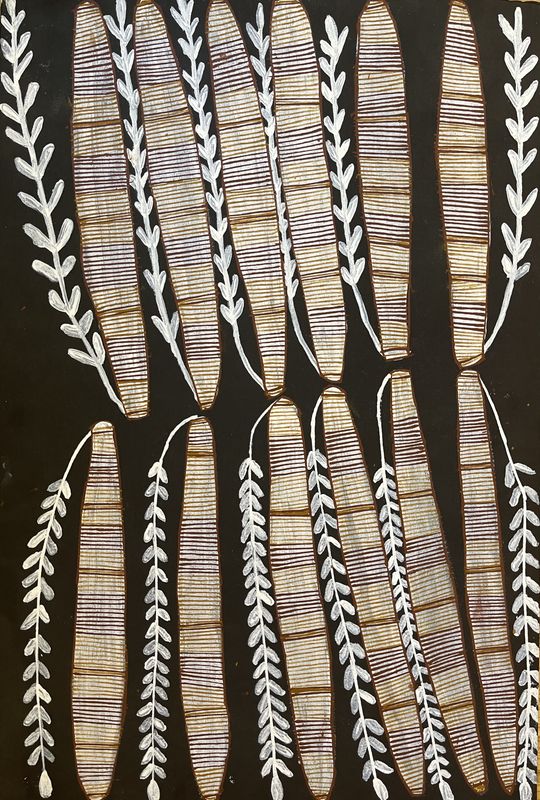Bob Wanurr Namundja
Wanurr Bob Namundja(c. 1933–2005) was a renowned artist born in western Arnhem Land to the Kardbam clan. He was a native speaker of Kunwinjku, a part of the Bininj Kunwok language group. His artistic journey, deeply rooted in the traditions of his heritage, has left a significant impact on the art and culture of western Arnhem Land.
Bob NAMUNDJA grew up in the bush around the Mankorlod region of western Arnhem Land. He spent much of his life travelling, participating in ceremonies and maintaining his extended kin network. In addition to this, he worked for three decades as a stockman (‘seemed more like one hundred years’). He and his wife Dianne settled with their four children in Gunbalanya (Oenpelli) in the 1970s when Bob took up painting as a career. Courtesy Injalak Arts and Crafts Association, Gunbalanya
- Group Exhibitions 2006 L’art aborigène contemporain, Arts d’Australie, Stéphane Jacob / Médiathèque Cathédrale de Reims, Reims, France; Terre de Rêves, Terre des Hommes, Arts d'Australie, Stéphane Jacob / Musée de la Préhistoire, Bougon, France2005 The Art of Two Brothers: Bob Wanur Namundja and Don Nakadilinj Namundja. Curated by Andrew Blake, Marrawuddi Gallery, Kakadu National Park, NT2005 Terre de Rêves, Terre des Hommes, Arts d'Australie, Stéphane Jacob / Musée de la Préhistoire d’Île de France, Nemours, France; Terre de Rêves, Terre des Hommes, Arts d'Australie, Stéphane Jacob/Ambassade d’Australie, Paris, France1984-85 Kunwinjku Bim, Western Arnhem Land Paintings from the collection of the Aboriginal Arts Board, National Gallery of Victoria, Melbourne, VIC
- Collections: Australia Council Aboriginal Arts Board Collection , National Museum of Australia, CanberraAboriginal Art Museum, The Netherlands
- Bibliography 1979 Aboriginal Arts Board of the Australia Council, Oenpelli Bark Painting, Ure Smith, Sydney1984 Brody, A., Kunwinjku Bim: Western Arnhem Land Paintings from the Collection of the Aboriginal Arts Board, National Gallery of Victoria, Melbourne
- Moiety: Yirritja
- Subsection: Nawakadj
Artistic Journey Wanurr began painting professionally in the 1960s under the encouragement of linguist Peter Carroll through the Church Mission Society’s Oenpelli Mission. After the mission closed, he painted for Dorothy Bennett until the founding of the Injalak Arts Centre in 1989.
Influence and Style Wanurr was a senior manager of the Kunabibi ceremony alongside Bardayal Nadjamerrek, significantly influencing the depiction of Ngalyod (the Rainbow Serpent). Ngalyod, associated with fertility and seasonal changes, was a frequent subject in Wanurr’s work. He often portrayed Ngalyod in contemporary forms, using abstract approaches to capture the social shifts among Kunwinjku artists.
Wanurr’s style was influenced by the rock art heritage of his homeland, favouring a single, parallel-line infill (rarrk) technique. This style was shared with a small group of men from the southern clans of western Arnhem Land, including Dick Nguleingulei Murrumurru, Kalarriya "Jimmy" Namarnyilk, and his brother Don Nakadilinj Namundja. They maintained a figurative approach, contrasting with the more elaborate cross-hatching used by other artists.
Themes and Mediums Wanurr’s works often depicted plants, animals, and ancient spirits from Arnhem Land, using natural pigments on eucalyptus bark. He preferred earthy red and yellow colours, traditional in Aboriginal art, reflecting his deep connection to his cultural roots. His art frequently featured diamond shapes, associated with his Yirritja connection.
Life and Legacy During the 1960s, Wanurr lived on the Oenpelli Mission (now Gunbalanya). With the rise of the outstation movement in the 1970s, he split his time between Gunbalanya and Makorlod. By the mid-1980s, he returned to Gunbalanya with his wife Dianne and their four children, working as a police tracker. He also worked as a stockman in Central Arnhem Land.
Wanurr traveled extensively throughout Australia, participating in cultural ceremonies and maintaining strong ties with his extended family. His brother, Don Nakadilinj Namundja, also became a notable artist.


